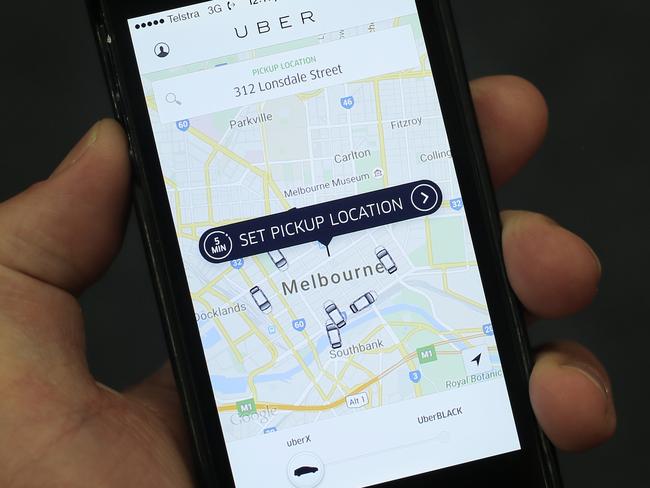Barefoot Investor: What you need to know about the Uber hack
UBER has fessed up to the fact it has been hacked — with the account details of 57 million users and drivers stolen. So how do you know if you’re among the one in 10 Aussies affected, asks the Barefoot Investor?

Barefoot Investor
Don't miss out on the headlines from Barefoot Investor. Followed categories will be added to My News.
IF you’ve got an Uber account, you really need to read this.
You may have heard that this week Uber fessed up to the fact it had been hacked in October last year — with the names and contact details of 57 million of its user and driver accounts being stolen. But instead of making the breach public, they paid the hackers $100,000 to destroy the copied data.
Trustworthy fellows, those hackers. I’m sure they did what they said … even used the recycling bin, right?
Here’s you: “Uber are clearly morons ... but how does this affect me?”
Here’s me: “The Australian is reporting that ‘more than one in ten Aussies may have been affected’.”
So how do you know if you’re the one in ten?
Uber paid hackers to delete stolen data
Even with hacking, I won’t go back to taxis

Well, Uber is continuing to dig its hole — they’ve decided not to contact customers whose data has been breached, and instead have said they’re “monitoring the affected accounts and have flagged them for additional fraud protection”. Poor form!
It’s like if you find out you’ve got an STD. The right thing to do is to ring up your former partner and say, “Look I probably deserve a slap, but you’d better get tested ... because I’ve got the clap”.
Uber is doing the equivalent of checking in on your ex’s Instagram every now and again to ensure none of their bits are mysteriously falling off.
For the record, if this hack happened next year, Uber would be toast. That’s because laws to be introduced next February will force organisations to contact victims and report data theft to the Australian Privacy Commissioner.
Uber hack: More than 1 in 10 Aussies may be victims of ‘astonishing’ data breach
So what can you do if you have an Uber account? Three things.
First, you should assume that your details have been breached.
Second, you should change all your passwords. If you’re normal, you have one password that you use for everything. Stop doing that, and start looking into encrypted password vaults like LastPass.
Third, you should check your credit file, which you can get for free if you write to the credit agencies.
Actually, for $79.95 you can get your file plus an alert system that pings you if any changes are made to your credit file for 12 months, via MyCreditFile.com.au. Hang on, can you trust MyCreditFile.com.au?
Err, well, it’s a product of credit reporting agency Equifax (formerly Veda Advantage), which earlier in the year suffered one of the biggest data breaches in history.
Tread Your Own Path!
MOTHER OF ALL LUNACY
GILLIAN ASKS: My soon-to-be mother-in-law is bad with money.
She has over $100,000 in credit card debt, as well as a couple of 60-month interest-free loans that were never paid and are now charging 29.99% interest.
My fiance (we are both 25) is considering getting a loan in his name to “help” her, but I believe she will just go back to her old ways.
I worry about this debt when it comes to us buying our first home or if she does not pay for the loan.
Over the past two months, we have already paid $5000 for her bills. Help me!
BAREFOOT REPLIES: There’s no such thing as one Smartie.
That’s the lesson I’ve learned from my two-year-old: I give him a Smartie, knowing full well that it sets me up for a full-blown tanty if I don’t give him a second one.

After paying $5000 of his mum’s bills, that’s the situation your fiance is facing (and it sounds like your mother-in-law is behaving like a toddler — not so smartie).
Bottom line?
Your mother-in-law is financially crazy. And you’re absolutely within your rights not to invite crazy into your life — and you sure as hell don’t need to be guilted into funding her stupidity.
However, that’s a harsh message to deliver to your fiance.
So here’s what I’d do instead:
Explain to your fiance that your mother-in-law needs love, kindness and understanding.
She needs expert guidance.
She needs a financial hero who can help her … in fact, she needs James Bond! Or, more accurately, she needs to call the non-profit Financial Counselling Australia hotline on 1800 007 007.
However, if she’s stamping her foot, quivering her lip and demanding another Smartie, you may need to book an appointment on her behalf.
You should even offer to go with her — that’s what a loving daughter-in-law would do. The counsellors are the best people to help her face the reality of the decisions she’s made, and provide solutions for her.
Now repeat after me: no more Smarties!
A TAXING QUESTION
BEN ASKS: I am a 32-year-old tax accountant earning $100,000 a year — and I am facing a dilemma. I could (for $300,000) buy in as a partner in the accounting firm where I work, replacing a partner who is soon to retire.
But I am not happy at this place and have always wanted to start my own accounting business. I already have some clients on the side, worth about 20 per cent of my salary. Would quitting my job and going it alone be the right move?
BAREFOOT REPLIES: You haven’t said how much partners get paid at your firm, and therefore how long it would take to earn back your investment. But I don’t think it really matters. If you’re not happy there, why would you sink $300k into it?
Personally, I think being in a traditional suburban accounting firm is a really tough business, and it’s only getting tougher.
In the coming years technological advancements like “blockchain” and artificial intelligence will revolutionise the industry.
Even now, the bread-and-butter business of tax preparation and compliance is dwindling — and if Labor gets in they’ve promised to limit deductions for tax advice to $3000 a year. (OK, so that last one doesn’t have legs — I’m sure it just means that accountants will charge clients “financial strategy” fees instead.)

Still, there’s no doubt in my mind that accounting is going to look very different in 20 years. To succeed you’ll need to be a trusted financial adviser to businesses, rather than a suburban cardigan-wearer doing tax prep.
If I were in your shoes I’d do what I call “swinging on the trapeze” — that is, keep your $100k-a-year job (holding on to the trapeze bar) while you invest time and money into building up your side hustle, then move to it full-time when you’re ready (landing on the other side of the trapeze). That way you might just create a business you’ll want to spend the next 30 years in.
WHERE’S MY MOJO?
WENDY ASKS: I am successfully following your instructions on splitting my income — 10 per cent to “Splurge”, 10 per cent to “Smile”, 20 per cent to “Fire Extinguisher” and $3000 in “Mojo”.
I see in the book it says that Mojo will grow, but I cannot find any instructions on how to add to it. Is this something we add to later in the process, or have I missed something?
BAREFOOT REPLIES: You’ve shot off an email at page 132, haven’t you!
You just need to keep reading. In fact, you remind me of trying to watch a movie with my wife. She sits on the couch next to me whispering, “Why did he kill her? I thought she was on his side?”
To which I reply, “I don’t know either — let’s wait and find out.”
So let me lay out the closing credits for you. My book is organised into nine Barefoot Steps that you complete in order, one by one:
Step 1: Schedule a Monthly Barefoot Date Night
Step 2: Set Up Your Buckets
Step 3: Domino Your Debts
Step 4: Buy Your Home
Step 5: Boost Your Super to 15%
Step 6: Boost Your Mojo to 3 Months
Step 7: Get the Banker off Your Back
Step 8: Nail Your Retirement Number
Step 9: Leave a Legacy
The power of the Barefoot Steps is that they focus on you doing just one thing at a time.
You won’t get overwhelmed.
Just move through them one at a time.
The Barefoot Investor holds an Australian Financial Services Licence (302081). This is general advice only. It should not replace individual, independent, personal financial advice
Originally published as Barefoot Investor: What you need to know about the Uber hack
